Search Results for base
Explore AI generated designs, images, art and prompts by top community artists and designers.

a fat butty pokemon character in a blue shirt and red cap , ash ketchum , ass , 9boys , 9clones , 9 ash ketchums , hat , looking back , fingerless gloves , pants , brown eyes , ass focus , gloves , black hair , shoes , huge ass , short hair , baseball cap , male focus , black gloves , red headwear , looking at viewer ,

a fat butty pokemon character in a blue shirt and red cap , ash ketchum , ass , 5boys , 5clones , 5 ash ketchums , hat , looking back , fingerless gloves , pants , brown eyes , ass focus , gloves , black hair , shoes , huge ass , short hair , baseball cap , male focus , black gloves , red headwear , looking at viewer ,

a fat butty pokemon character in a blue shirt and red cap , ash ketchum , ass , 4boys , 4clones , 4 ash ketchums , hat , looking back , fingerless gloves , pants , brown eyes , ass focus , gloves , black hair , shoes , huge ass , short hair , baseball cap , male focus , black gloves , red headwear , looking at viewer ,

a fat butty pokemon character in a blue shirt and red cap , ash ketchum , ass , 4boys , 4clones , 4 ash ketchums , hat , looking back , fingerless gloves , pants , brown eyes , ass focus , gloves , black hair , shoes , huge ass , short hair , baseball cap , male focus , black gloves , red headwear , looking at viewer ,

a fat butty pokemon character in a blue shirt and red cap , ash ketchum , ass , 3boys , 3clones , 3 ash ketchums , hat , looking back , fingerless gloves , pants , brown eyes , ass focus , gloves , black hair , shoes , huge ass , short hair , baseball cap , male focus , black gloves , red headwear , looking at viewer ,

a fat butty pokemon character in a blue shirt and red cap , ash ketchum , ass , 2boys , 2clones , 2 ash ketchums , hat , looking back , fingerless gloves , pants , brown eyes , ass focus , gloves , black hair , shoes , huge ass , short hair , baseball cap , male focus , black gloves , red headwear , looking at viewer ,

Будівельна тематика «BASE» 🏗 база як фундамент: цеглини , блоки , будівельні інструменти у стилізованому мінімалізмі; кожен предмет як окремий «будівельний блок» успіху 1 слайд CAMON BASE Безкоштовний марафон уся база НМТ з 5 предметів за 5 годин! можливість мати 140+ вже в кінці вересня Математика Історія Укр мова Біологія Англійська 29 вересня - 3 жовтня | Безкоштовно ,

a monumental colossal hairy giant muscular but fat bald white 30-year-old football lineman soldier in a camo tank top , massive hairy bloated pectoral muscles , head surrounded by massive bloated hairy muscles , sitting on the deck of an aircraft carrier , flexing his arm muscles over his head , he towers over his small white man friend in a shirt who is looking up at him in awe , military tattoos , trimmed short goatee , soft smile , kind eyes , baseball hat ,

Create a full-body image by combining the two provided photos. Compose them so the man lifts the woman in a natural embrace inside an elevator. Use the man's body and pose from Image 1 and the woman's body and face from Image 2 — preserve both faces and facial features exactly , without any alteration. Use the elevator interior from Image 1 as the base background but recolor and warm it to a luxurious golden brushed-metal finish (keep realistic reflections). Clothing and accessories: woman should wear a very light/powder pastel pink tight bodycon dress; over it , a matte black leather cropped jacket (zipped open or unzipped); matte silver platform shoes. Adjust and tidy the woman's hair into a tight high ponytail (preserve her face). Add subtle silver jewelry for the woman (earrings and thin necklace). For the man , keep his original clothing but add a realistic gold chain necklace and a gold bracelet on his wrist. Lighting and mood: photorealistic , warm golden lighting consistent across both subjects; match skin tones , shadows , and reflection in elevator mirror. Ensure natural contact shadows where bodies touch; add realistic reflections on elevator walls and floor aligned with lighting. If full legs or lower body are missing in sources , generate them to match perspective and proportions. Maintain high-resolution detail , fabric texture and realistic materials (matte leather , metallic platforms , gold/silver jewelry). Do not smooth or alter faces , remove blemishes , or change facial expressions. Final output: vertical 9:16 , full-length , high-resolution JPEG , with seamless blending , consistent shadows , and minimal grain to match originals. Pay careful attention to edges , scale , and perspective so the pair looks naturally posed as if photographed together in the elevator mirror selfie. ,

The Refueling Station: Generate an image of an abandoned refueling station , hovering above the turbulent , colorful clouds of a gas giant planet. The station is designed to refuel spacecraft and has large fuel storage tanks connected to a network of pipelines and hoses. The abandoned base is surrounded by a dense , thick mist , and the image should convey a sense of isolation and desolation. The station should feature intricate details such as rusted metal grates , leaking pipes , and discarded equipment. ,

A post-apocalyptic scene featuring a fierce female pilot standing in front of a massive , heavily space ship(aircraft:1.2). The pilot wears a vibrant flight suit mit aperture , with furcape , evoking a rebellious , edgy aesthetic. The setting is a dusty , desolate futuristic mecha inspired base with scattered debris and remnants of other vehicles , under a dramatic sky filled with scattered clouds (dramatic:1.2). The lighting casts harsh shadows , enhancing the rugged texture of the pilot's suit and the aircraft's surface , while the sun's rays create a striking contrast (high-contrast:1.2). Compositionally , the pilot is centered in the foreground , with the aircraft emerging from the background , drawing the viewer's eye (focus:1.2). Avoid clichés like generic sci-fi elements or cartoonish designs (negative prompt:2). Emphasize realism and detail , focusing on textures and atmospheric depth , leading the eye into the scene while emphasizing its detail. Focus on hyper-realistic textures (texture:1.2) and vivid colors (color:1.2) ,

Realistic 1/7 scale action figure of muscular figure , perhaps a female muscular bodybuilder , throwing a punch that creates a shockwave of stardust and energy across on a poster for a 'Boxing Championship' , clear acrylic base , poster showing ZBrush sculpting process of the same figure , BANDAI-style poster with the figure inside in the background , Bold , geometric shapes and a limited , high-contrast color palette of deep blues , purples , and electric yellows define the aesthetic , impactful design principles of modern sports advertising , ,

A full-body portrait of a graceful geisha—fixed on the left side of the frame , positioned slightly lower in composition , with a slight side profile (subtle , elegant facial angle); with traditional geisha hairstyle (neatly coiled chignon , sleek and structured) , adorned with pearl floral hair ornaments + small fresh peach blossom/camellia blooms (natural , not excessive) tucked into the hair gap , hair surface smooth and glossy , no messy strands; classic geisha makeup with soft finish: pale porcelain-like facial base , delicate pink-blush on cheeks (natural flush , not heavy) , defined black eyeliner (slightly elongated at the outer corners , elegant not sharp) , soft matte red lips (rich but not vivid , matching the red kimono) , subtle pearlescent highlighter on the cheekbones and brow bones (echoing the kimono's pearl luster) , neat and thin arched eyebrows—in a luxurious red kimono with an extra-wide hem that spreads open like an expanded fan (no dragging on the ground , flat and neat , no excessive folds , clean and majestic look); kimono embroidered with peonies , chrysanthemums , intricate blossoms , evenly covered in neatly arranged , orderly round pearls (no clutter , lustrous , soft glow: pastel pink , beige , pearl white , soft blue); geisha holds a white-golden parasol; upper left side of the frame shows the edge of a larger golden traditional Japanese wooden pavilion’s eave (partial , subtle detail , scaled up for visibility) , while the upper right side—fixed position—features a significantly larger golden traditional Japanese wooden pavilion (prominent size , clear structural details) standing on the lake surface , with several rockeries scattered on the lake; the upper-right golden pavilion and rockeries have clear reflections in the lake water , surrounded by blooming natural peach blossoms (with big , fully open petals) , peonies , and camellias (all with large , distinct petals , rendered in realistic style , no pearls); detailed natural foreground plants and flowers , Art Nouveau style , aestheticism , dreamy and ornate , highly detailed , ultra HD , 8K , elegant composition , jeweled artwork , pearls only on the kimono ,

Create a set of modern , dynamic logo designs for a karting brand called Gadget Go Rentals The logos should convey Gadgets like Cellphones , laptops , Drones , Vrboxes , Cameras adrenaline , and competition. Use a bold , sleek style with sharp lines or fluid motion effects. Consider incorporating elements like: A stylized kart silhouette with motion blur/light trails An abstract Man in a pose Neon/cyberpunk accents (optional) Color schemes tok inside explore: Black + neon blue/orange Red + white + black (classic racing) Metallic silver/gradient with electric purple Retro 80s (pink , teal , yellow) Variations: One version with a circular badge style (like F1 teams) One angular/esports-style emblem One minimalist text-based logo with speed lines Use high contrast for visibility on small prints and digital media. Avoid clutter—keep it iconic and scalable ,
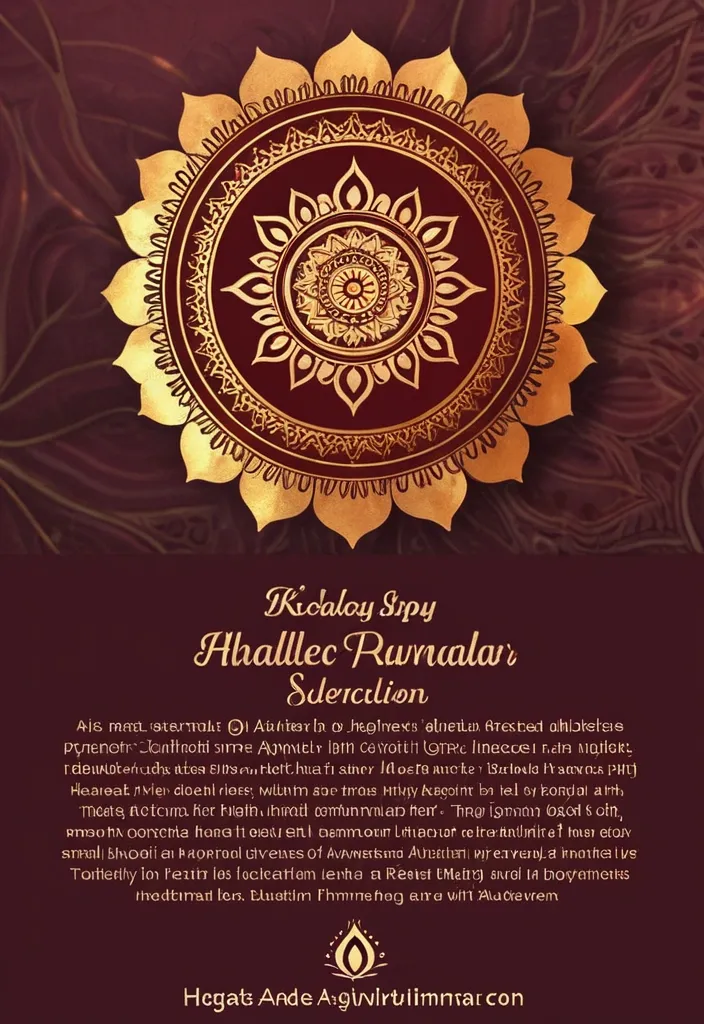
Kaamraj Range & Wellness Solutions Men’s Wellness & Power Supplements Enhancement & Specialty Oils Hair , Beauty & Liver Care Protein & Nutrition (Akhada Protein Butter) Future Pipeline: HIV , Cancer , Piles , Diabetes , Ortho , Stress & Women’s Wellness Brahmanand Ayurveda Pvt. Ltd. Trusted Ayurvedic Formulations for Strength , Vitality & Holistic Health ✨ Suggestion for background design: Gradient base: Deep maroon → warm golden → herbal green blend Texture: subtle Ayurvedic patterns / mandala motifs / natural leaf texture overlay Accent: gold shimmer lines or glowing aura effect behind the text ,

A photorealistic wide 16:9 scene of a massive ancient stone Buddha face , partially overgrown with moss , ivy , and tall trees that intertwine with the sculpture , blending nature and spirituality. The serene expression of the Buddha emerges from a lush green forest , where towering trees and dense vegetation surround the monument. A majestic waterfall cascades down from the side of the statue , creating mist and reflecting soft light , while a crystal-clear river flows at its base. Sunlight filters through the canopy , casting golden rays on the moss-covered stone and sparkling water. The atmosphere is peaceful , mystical , and awe-inspiring , with incredible attention to detail in the textures of stone , bark , leaves , and water. ,
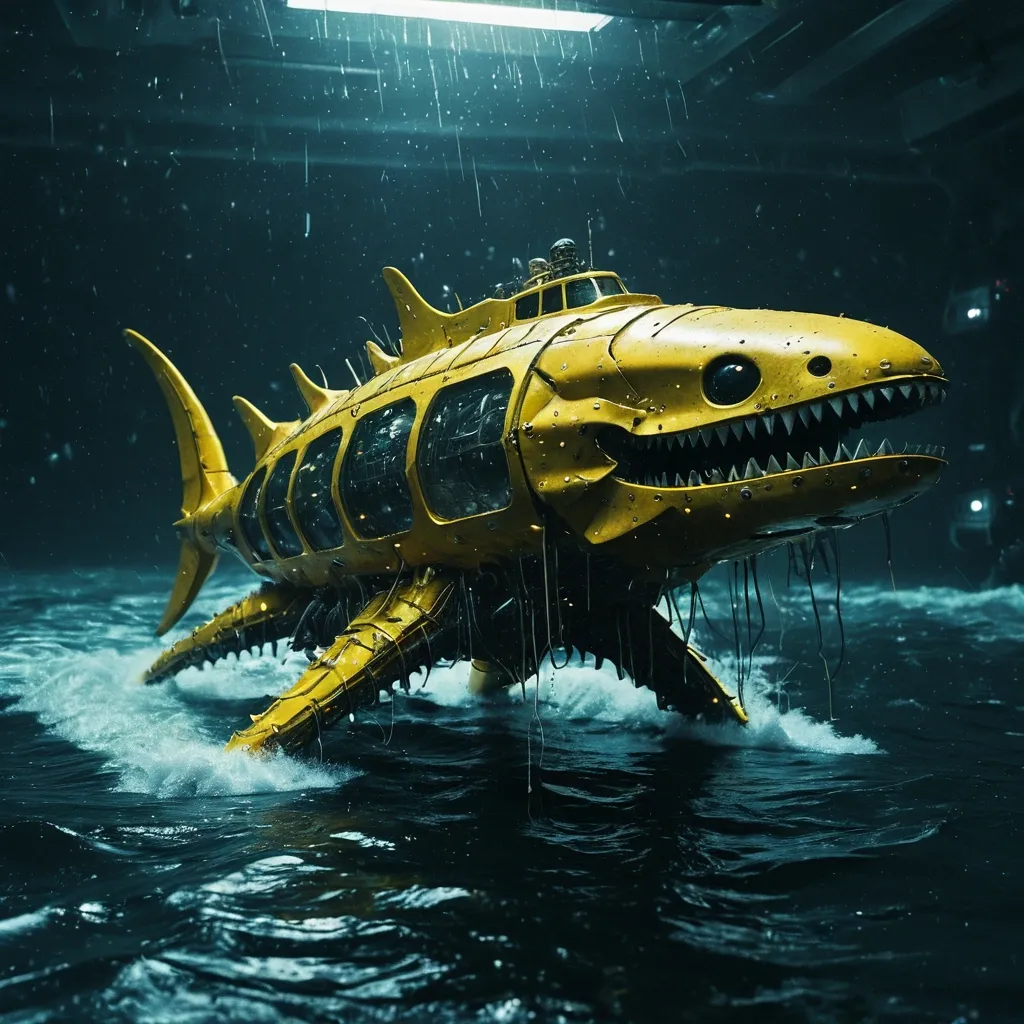
A vividly surreal and cinematic photograph of a grotesque , intergalactic whale shape spacecraft with razor-sharp monstrous teeth , set against a dimly lit , eerie , detailed tinted glass windows , metallic yellow shell , many lights , line air landing inside a realistic detailed ground military base in the middle of the Ocean water splash , a female riding Fly-board (a brand of hydroflighting device) Xenomorph through on a ocean , motion speedy , captured in photo-realistic detail with a gritty , analogue film grain , as if torn from the pages of a macabre fairy tale , space art ,

Two separate cute 3D renders for a baseball jersey design: Front side: Hello Kitty wearing a pink and white astronaut suit with a transparent space helmet , holding a baseball bat and swinging to hit a baseball , wearing a baseball cap with the "LA Dodgers" logo on the front , and the same "LA Dodgers" logo on the chest of her suit , dreamy pastel pink and purple cosmic background with fluffy clouds , sparkling stars , and colorful planets , soft lighting , ultra high detail , kawaii style , centered composition , no text , no watermark. Back side: Hello Kitty wearing the same pink and white astronaut suit , sitting on top of a small pastel-colored planet with a pink ring around it , holding a baseball glove catching a baseball , wearing the same baseball cap with the "LA Dodgers" logo , and the same logo on the back of her suit , dreamy pastel pink and purple cosmic background with fluffy clouds , sparkling stars , and other planets , soft lighting , ultra high detail , kawaii style , centered composition , no text , no watermark. Both images should have matching color tones and style , suitable for printing on a sports jersey. ,

Two separate cute 3D renders for a baseball jersey design: Front side: Hello Kitty wearing a pink and white astronaut suit with a transparent space helmet , holding a baseball bat and swinging to hit a baseball , dreamy pastel pink and purple cosmic background with fluffy clouds , sparkling stars , and colorful planets , soft lighting , ultra high detail , kawaii style , centered composition , no text , no watermark. Back side: Hello Kitty wearing the same pink and white astronaut suit , sitting on top of a small pastel-colored planet with a pink ring around it , holding a baseball glove catching a baseball , dreamy pastel pink and purple cosmic background with fluffy clouds , sparkling stars , and other planets , soft lighting , ultra high detail , kawaii style , centered composition , no text , no watermark. Both images should have matching color tones and style , suitable for printing on a sports jersey. ,

Two separate cute 3D renders for a baseball jersey design: Front side: Hello Kitty wearing a pink and white astronaut suit with a transparent space helmet , holding a baseball bat and swinging to hit a baseball , dreamy pastel pink and purple cosmic background with fluffy clouds , sparkling stars , and colorful planets , soft lighting , ultra high detail , kawaii style , centered composition , no text , no watermark. Back side: Hello Kitty wearing the same pink and white astronaut suit , sitting on top of a small pastel-colored planet with a pink ring around it , holding a baseball glove catching a baseball , dreamy pastel pink and purple cosmic background with fluffy clouds , sparkling stars , and other planets , soft lighting , ultra high detail , kawaii style , centered composition , no text , no watermark. Both images should have matching color tones and style , suitable for printing on a sports jersey. ,

A high-tech industrial robotic media production station with multiple articulated arms mounted on a stable mechanical base platform , inspired by advanced industrial manipulators and spider-drone engineering. No humanoid legs or head — instead , a central cylindrical module houses an array of optical sensors , precision lenses , LED light indicators , and integrated holographic projectors. The robot is designed for creative media work , not combat — smooth aerodynamic contours with reduced sharp edges , and numerous embedded holographic and light-based UI elements showing AI interfaces , media timelines , live video feeds , and floating icons of Instagram and YouTube. Each arm has integrated tools: a built-in 8K camera module , a ring light embedded in the arm structure , directional microphones , a fold-out tablet screen , and holographic control panels — all seamlessly part of the mechanical design , not handheld. Premium materials: glossy aviation-grade bright red paint (#FF1C1C) with asphalt-dark gray (#2B2B2B) structural panels , anodized metal joints , carbon fiber inserts , and fine blue-turquoise seam lighting. Ultra-detailed photorealistic textures with bolts , seams , micro-scratches , and realistic reflections. Cinematic lighting with clean white highlights , subtle shadows , and product showcase style — isolated on a transparent background with a soft gradient light spot beneath , as if presented at an Apple/DJI launch. High-poly model , no cartoonish simplification , no text or logos. ,
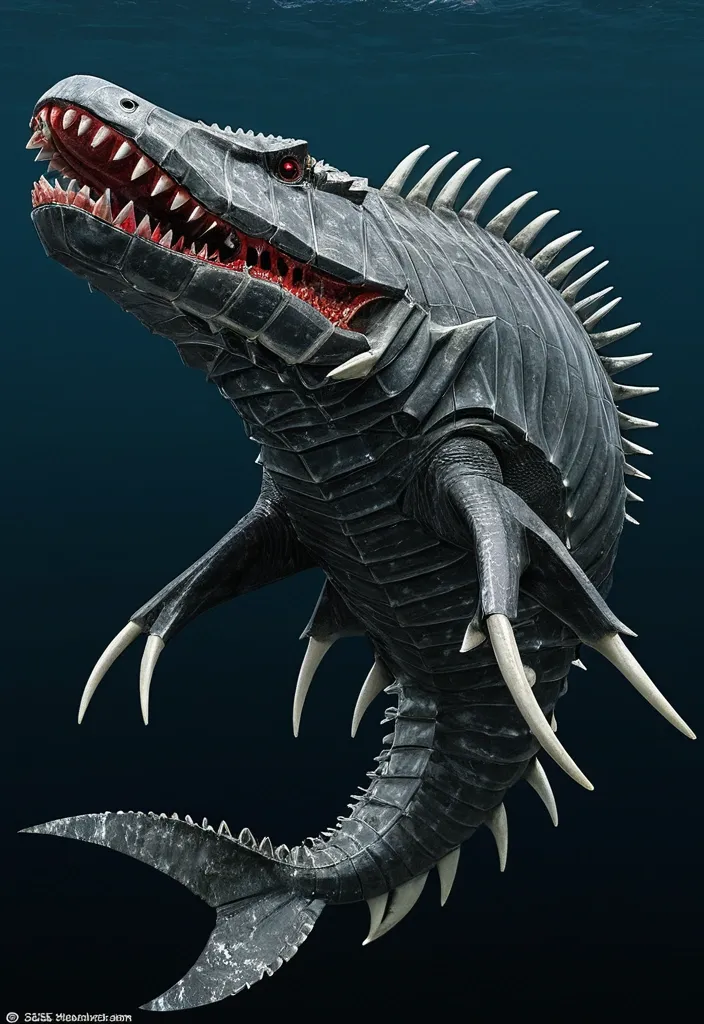
Female , Length: 40-60 feet , Weight: 50-75 tons , Lifespan: 100-135 years , Color is a slate gray base with white and red photophores arranged in tiger stripe patterns along the flanks and dorsal ridge , glowing vividly in abyssal darkness , a Robust , muscular frame combining the thick , armored scales of saltwater crocodile and arapaima with a hydrodynamic , flexible body of Mosasaurus Hoffmannii , Large , rigid pectoral fins capable of tilting backward to reduce drag , inspired by the Black Marlin’s speed adaptations , Powerful flippers adapted for both swimming and short-distance land movement , similar to a leopard seal’s scooting style , Enormous , reinforced jaws with over 40 , 000 PSI bite force , lined with long , razor-sharp canine teeth from Predator X and Megalodon genetics , Venomous spines inspired by the crown-of-thorns starfish line the dorsal ridge , delivering painful wounds to predators or rivals. ,
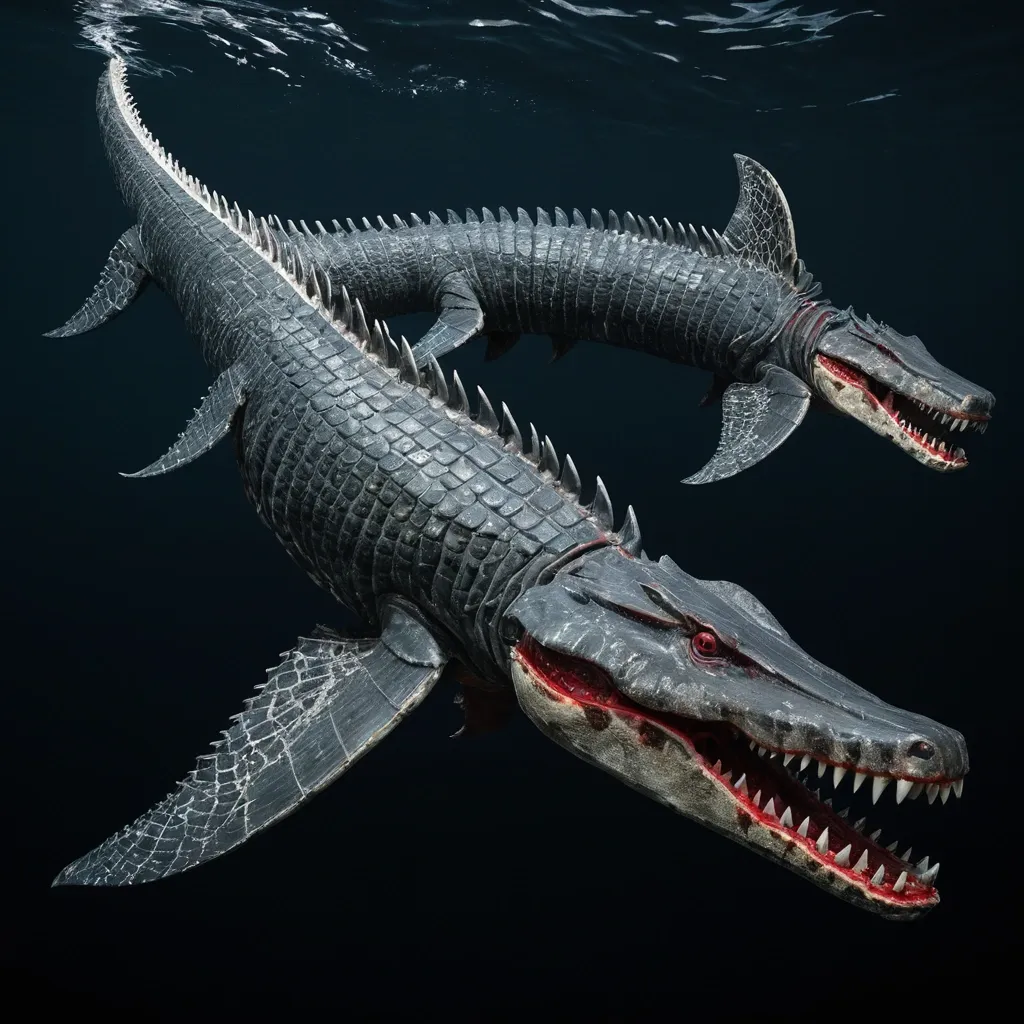
Female , Length: 40-60 feet , Weight: 50-75 tons , Lifespan: 100-135 years , Color is a slate gray base with white and red photophores arranged in tiger stripe patterns along the flanks and dorsal ridge , glowing vividly in abyssal darkness , a Robust , muscular frame combining the thick , armored scales of saltwater crocodile and arapaima with a hydrodynamic , flexible body of Mosasaurus Hoffmannii , Large , rigid pectoral fins capable of tilting backward to reduce drag , inspired by the Black Marlin’s speed adaptations , Powerful flippers adapted for both swimming and short-distance land movement , similar to a leopard seal’s scooting style , Enormous , reinforced jaws with over 40 , 000 PSI bite force , lined with long , razor-sharp canine teeth from Predator X and Megalodon genetics , Venomous spines inspired by the crown-of-thorns starfish line the dorsal ridge , delivering painful wounds to predators or rivals. ,
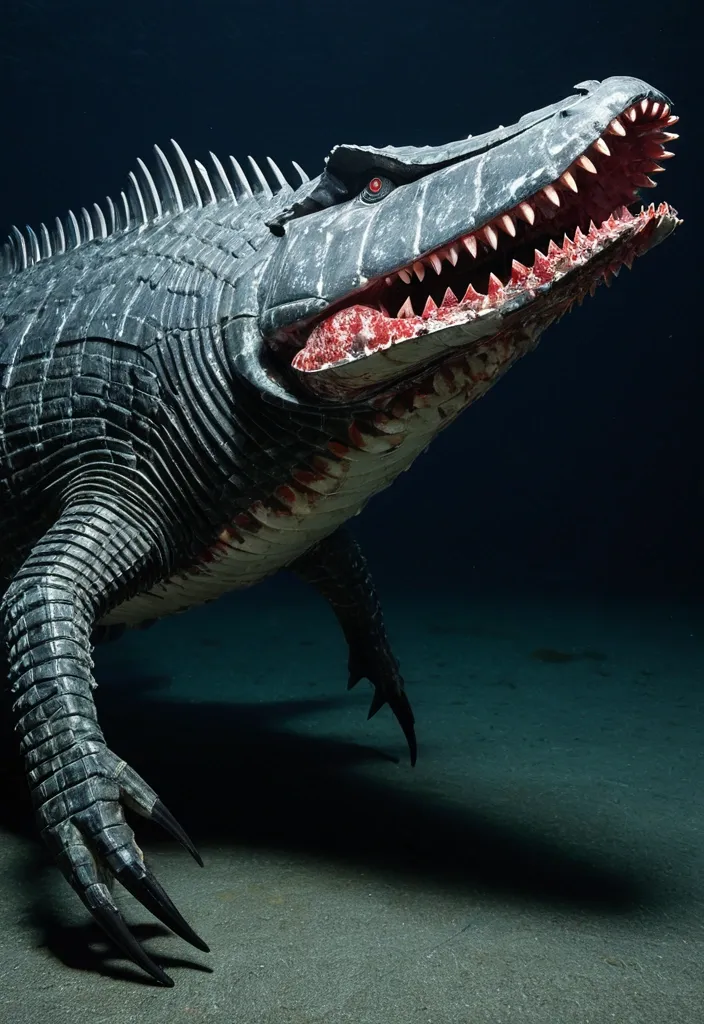
Female , Length: 40-60 feet , Weight: 50-75 tons , Lifespan: 100-135 years , Color is a slate gray base with white and red photophores arranged in tiger stripe patterns along the flanks and dorsal ridge , glowing vividly in abyssal darkness , a Robust , muscular frame combining the thick , armored scales of saltwater crocodile and arapaima with a hydrodynamic , flexible body of Mosasaurus Hoffmannii , Large , rigid pectoral fins capable of tilting backward to reduce drag , inspired by the Black Marlin’s speed adaptations , Powerful flippers adapted for both swimming and short-distance land movement , similar to a leopard seal’s scooting style , Enormous , reinforced jaws with over 40 , 000 PSI bite force , lined with long , razor-sharp canine teeth from Predator X and Megalodon genetics , Venomous spines inspired by the crown-of-thorns starfish line the dorsal ridge , delivering painful wounds to predators or rivals. ,
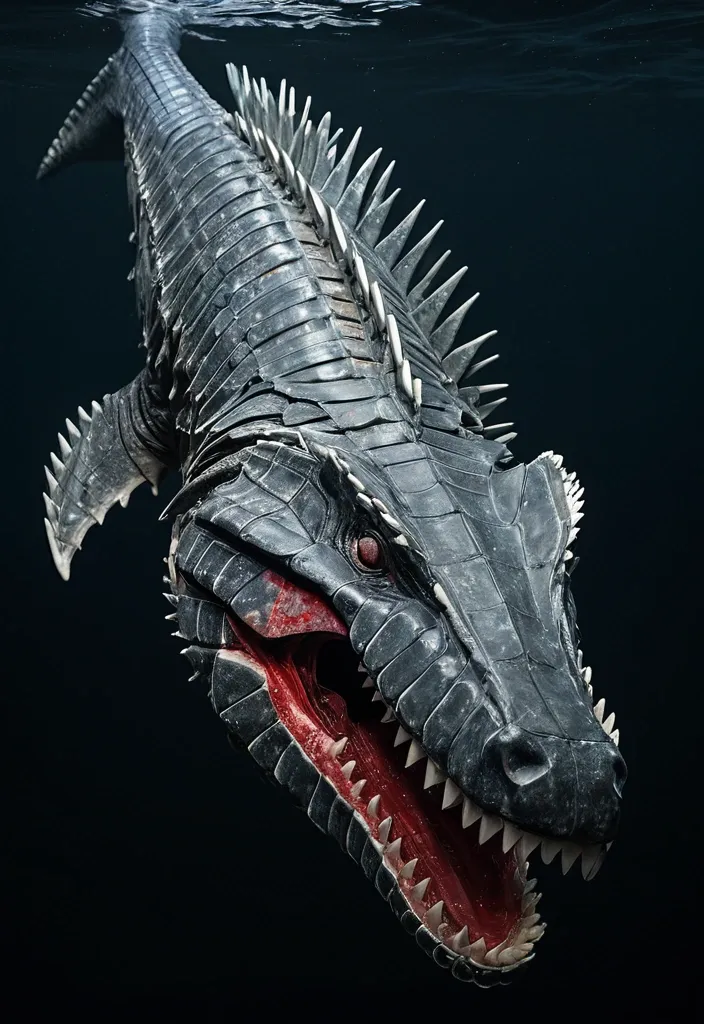
Female , Length: 40-60 feet , Weight: 50-75 tons , Lifespan: 100-135 years , Color is a slate gray base with white and red photophores arranged in tiger stripe patterns along the flanks and dorsal ridge , glowing vividly in abyssal darkness , a Robust , muscular frame combining the thick , armored scales of saltwater crocodile and arapaima with a hydrodynamic , flexible body of Mosasaurus Hoffmannii , Large , rigid pectoral fins capable of tilting backward to reduce drag , inspired by the Black Marlin’s speed adaptations , Powerful flippers adapted for both swimming and short-distance land movement , similar to a leopard seal’s scooting style , Enormous , reinforced jaws with over 40 , 000 PSI bite force , lined with long , razor-sharp canine teeth from Predator X and Megalodon genetics , Venomous spines inspired by the crown-of-thorns starfish line the dorsal ridge , delivering painful wounds to predators or rivals. ,
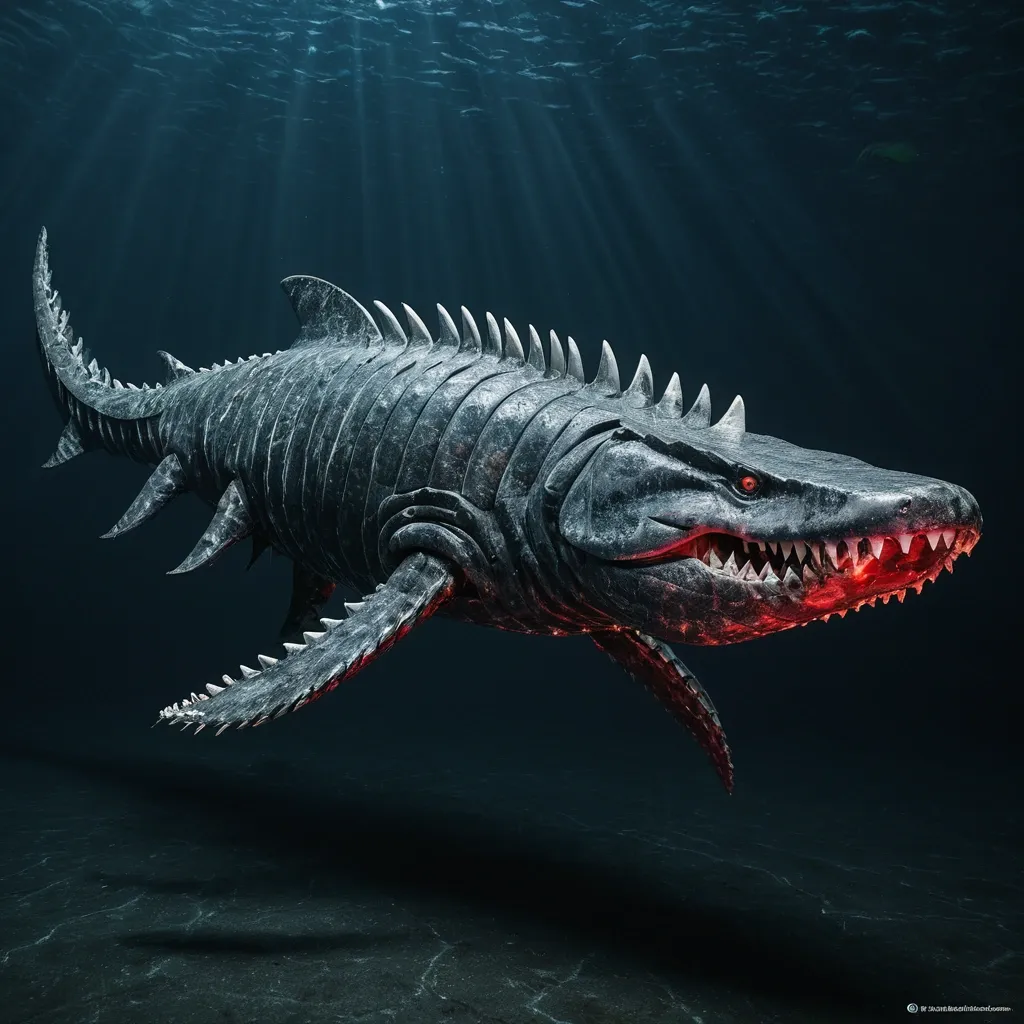
Female , Length: 40-60 feet , Weight: 50-75 tons , Lifespan: 100-135 years , Color is a slate gray base with white and red photophores arranged in tiger stripe patterns along the flanks and dorsal ridge , glowing vividly in abyssal darkness , a Robust , muscular frame combining the thick , armored scales of saltwater crocodile and arapaima with a hydrodynamic , flexible body of Mosasaurus Hoffmannii , Large , rigid pectoral fins capable of tilting backward to reduce drag , inspired by the Black Marlin’s speed adaptations , Powerful flippers adapted for both swimming and short-distance land movement , similar to a leopard seal’s scooting style , Enormous , reinforced jaws with over 40 , 000 PSI bite force , lined with long , razor-sharp canine teeth from Predator X and Megalodon genetics , Venomous spines inspired by the crown-of-thorns starfish line the dorsal ridge , delivering painful wounds to predators or rivals. ,
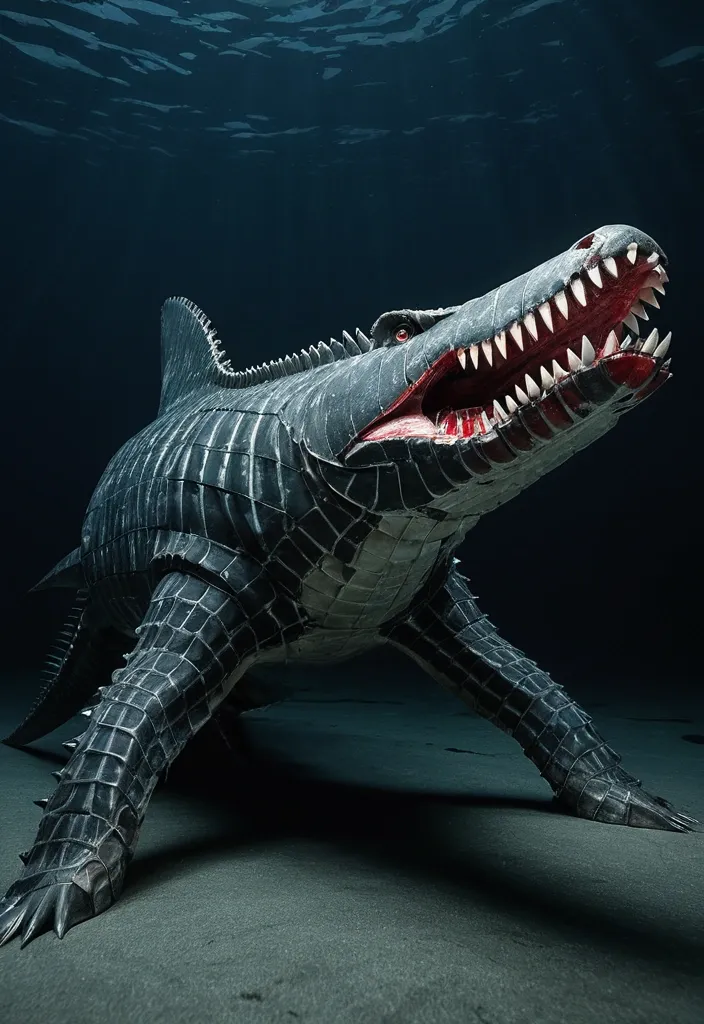
Female , Length: 40-60 feet , Weight: 50-75 tons , Lifespan: 100-135 years , Color is a slate gray base with white and red photophores arranged in tiger stripe patterns along the flanks and dorsal ridge , glowing vividly in abyssal darkness , a Robust , muscular frame combining the thick , armored scales of saltwater crocodile and arapaima with a hydrodynamic , flexible body of Mosasaurus Hoffmannii , Large , rigid pectoral fins capable of tilting backward to reduce drag , inspired by the Black Marlin’s speed adaptations , Powerful flippers adapted for both swimming and short-distance land movement , similar to a leopard seal’s scooting style , Enormous , reinforced jaws with over 40 , 000 PSI bite force , lined with long , razor-sharp canine teeth from Predator X and Megalodon genetics , Venomous spines inspired by the crown-of-thorns starfish line the dorsal ridge , delivering painful wounds to predators or rivals. ,
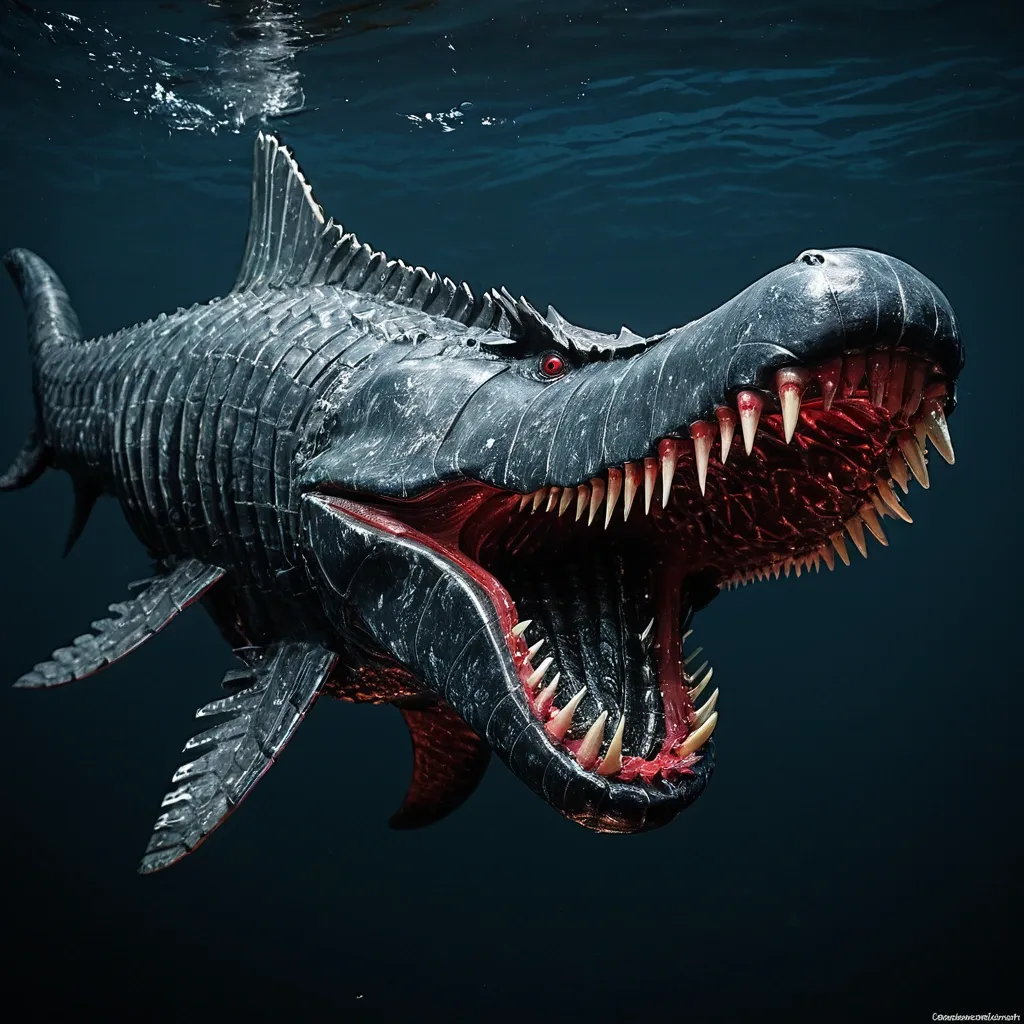
Males , Length: 40-60 feet , Weight: 50-75 tons , Lifespan: 100-135 years , Color is a Jet black base with red and light gray photophores arranged in a tiger stripe patterns along the flanks and dorsal ridge , glowing vividly in abyssal darkness , a streamlined , muscular frame combining the thick , armored scales of saltwater crocodile and arapaima with a hydrodynamic , flexible body of Mosasaurus Hoffmannii , Large , rigid pectoral fins capable of tilting backward to reduce drag , inspired by the Black Marlin’s speed adaptations , Powerful flippers adapted for both swimming and short-distance land movement , similar to a leopard seal’s scooting style , Enormous , reinforced jaws with over 40 , 000 PSI bite force , lined with long , razor-sharp canine teeth from Predator X and Megalodon genetics , Venomous spines inspired by the crown-of-thorns starfish line the dorsal ridge , delivering painful wounds to predators or rivals ,
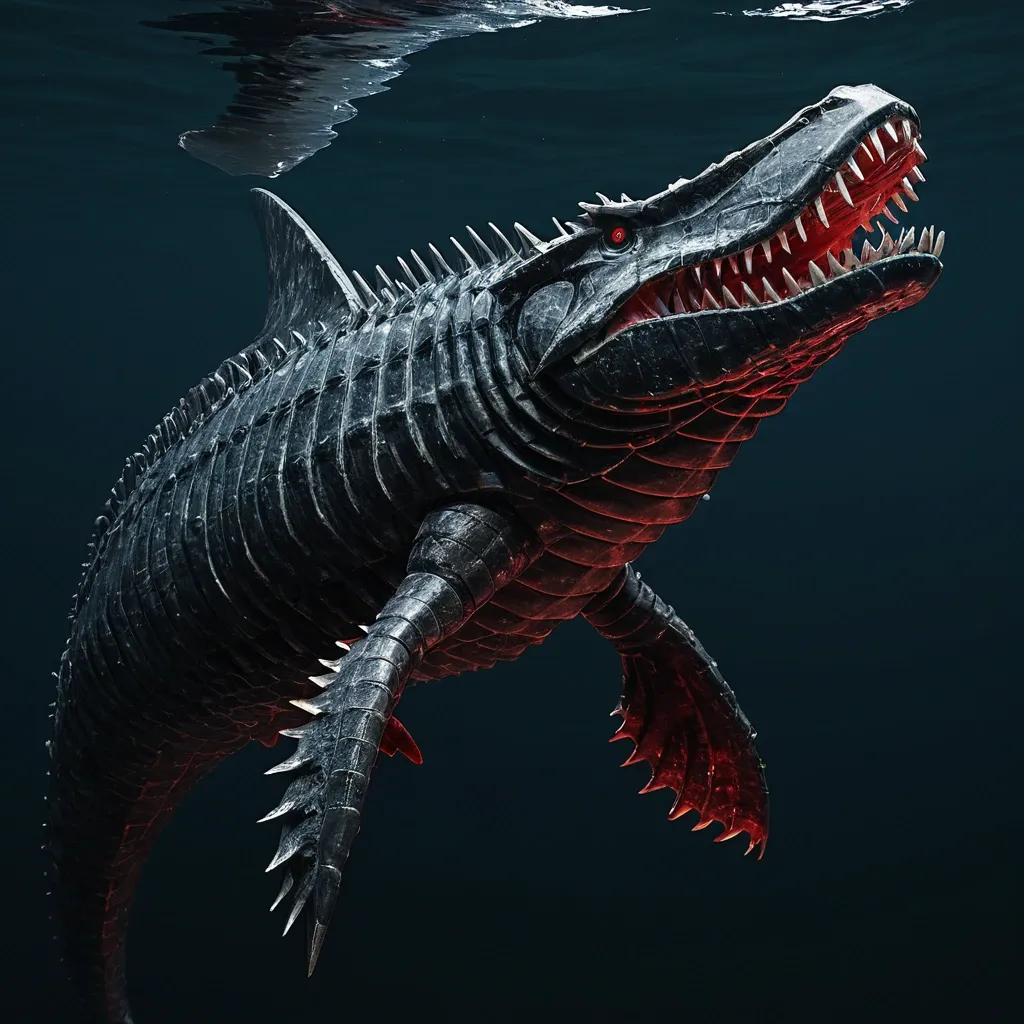
Males , Length: 40-60 feet , Weight: 50-75 tons , Lifespan: 100-135 years , Color is a Jet black base with red and light gray photophores arranged in a tiger stripe patterns along the flanks and dorsal ridge , glowing vividly in abyssal darkness , a streamlined , muscular frame combining the thick , armored scales of saltwater crocodile and arapaima with a hydrodynamic , flexible body of Mosasaurus Hoffmannii , Large , rigid pectoral fins capable of tilting backward to reduce drag , inspired by the Black Marlin’s speed adaptations , Powerful flippers adapted for both swimming and short-distance land movement , similar to a leopard seal’s scooting style , Enormous , reinforced jaws with over 40 , 000 PSI bite force , lined with long , razor-sharp canine teeth from Predator X and Megalodon genetics , Venomous spines inspired by the crown-of-thorns starfish line the dorsal ridge , delivering painful wounds to predators or rivals ,
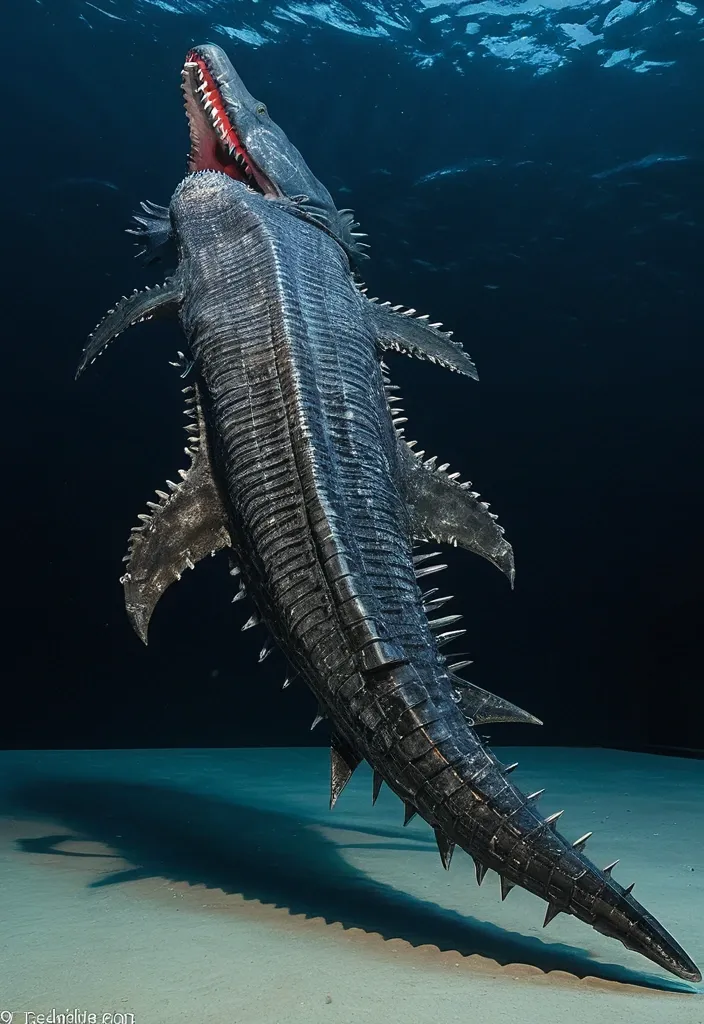
Males , Length: 40-60 feet , Weight: 50-75 tons , Lifespan: 100-135 years , Color is a Jet black base with red and light gray photophores arranged in a tiger stripe patterns along the flanks and dorsal ridge , glowing vividly in abyssal darkness , a streamlined , muscular frame combining the thick , armored scales of saltwater crocodile and arapaima with a hydrodynamic , flexible body of Mosasaurus Hoffmannii , Large , rigid pectoral fins capable of tilting backward to reduce drag , inspired by the Black Marlin’s speed adaptations , Powerful flippers adapted for both swimming and short-distance land movement , similar to a leopard seal’s scooting style , Enormous , reinforced jaws with over 40 , 000 PSI bite force , lined with long , razor-sharp canine teeth from Predator X and Megalodon genetics , Venomous spines inspired by the crown-of-thorns starfish line the dorsal ridge , delivering painful wounds to predators or rivals ,